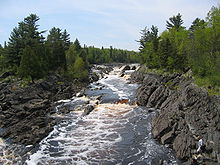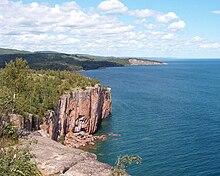Geology of Minnesota
See also: List of lakes in Minnesota and List of Minnesota rivers

 Tilted beds of the Middle PrecambrianThompson Formation in Jay Cooke State Park
Tilted beds of the Middle PrecambrianThompson Formation in Jay Cooke State Park
Minnesota contains some of the oldest rocks found on earth, gneissessome 3.6 billion years old, or 80% as old as the planet.About 2.7 billion years ago, basaltic lava poured out of cracks in the floor of the primordial ocean; the remains of this volcanic rock formed the Canadian Shield in northeast Minnesota. The roots of these volcanic mountains and the action of Precambrian seas formed theIron Range of northern Minnesota. Following a period of volcanism 1.1 billion years ago, Minnesota's geological activity has been more subdued, with no volcanism or mountain formation, but with repeated incursions of the sea, which left behind multiple strata of sedimentary rock.
In more recent times, massive ice sheets at least one kilometer thick ravaged the landscape of the state and sculpted its current terrain. The Wisconsin glaciation left 12,000 years ago. These glaciers covered all of Minnesota except the far southeast, an area characterized by steep hills and streams that cut into the bedrock. This area is known as the Driftless Zone for its absence of glacial drift. Much of the remainder of the state outside of the northeast has 50 feet (15 m) or more of glacial till left behind as the last glaciers retreated. GiganticLake Agassiz formed in the northwest 13,000 years ago. Its bed created the fertile Red River valley, and its outflow,glacial River Warren, carved the valley of the Minnesota River. Minnesota is geologically quiet today; it experiences earthquakes infrequently, and most of them are minor.


Palisade Head on Lake Superior formed from a Precambrian rhyolitic lava flow.
The state's high point is Eagle Mountain at 2,301 feet (701 m), which is only 13 miles (21 km) away from the low of 601 feet (183 m) at the shore of Lake Superior. Notwithstanding dramatic local differences in elevation, much of the state is a gently rolling peneplain.
Two major drainage divides meet in the northeastern part of Minnesota in rural Hibbing, forming a triple watershed.Precipitation can follow the Mississippi River south to the Gulf of Mexico, the Saint Lawrence Seaway east to the Atlantic Ocean, or the Hudson Bay watershed to the Arctic Ocean.
See also: List of lakes in Minnesota and List of Minnesota rivers

 Tilted beds of the Middle PrecambrianThompson Formation in Jay Cooke State Park
Tilted beds of the Middle PrecambrianThompson Formation in Jay Cooke State ParkMinnesota contains some of the oldest rocks found on earth, gneissessome 3.6 billion years old, or 80% as old as the planet.About 2.7 billion years ago, basaltic lava poured out of cracks in the floor of the primordial ocean; the remains of this volcanic rock formed the Canadian Shield in northeast Minnesota. The roots of these volcanic mountains and the action of Precambrian seas formed theIron Range of northern Minnesota. Following a period of volcanism 1.1 billion years ago, Minnesota's geological activity has been more subdued, with no volcanism or mountain formation, but with repeated incursions of the sea, which left behind multiple strata of sedimentary rock.
In more recent times, massive ice sheets at least one kilometer thick ravaged the landscape of the state and sculpted its current terrain. The Wisconsin glaciation left 12,000 years ago. These glaciers covered all of Minnesota except the far southeast, an area characterized by steep hills and streams that cut into the bedrock. This area is known as the Driftless Zone for its absence of glacial drift. Much of the remainder of the state outside of the northeast has 50 feet (15 m) or more of glacial till left behind as the last glaciers retreated. GiganticLake Agassiz formed in the northwest 13,000 years ago. Its bed created the fertile Red River valley, and its outflow,glacial River Warren, carved the valley of the Minnesota River. Minnesota is geologically quiet today; it experiences earthquakes infrequently, and most of them are minor.


Palisade Head on Lake Superior formed from a Precambrian rhyolitic lava flow.
The state's high point is Eagle Mountain at 2,301 feet (701 m), which is only 13 miles (21 km) away from the low of 601 feet (183 m) at the shore of Lake Superior. Notwithstanding dramatic local differences in elevation, much of the state is a gently rolling peneplain.
Two major drainage divides meet in the northeastern part of Minnesota in rural Hibbing, forming a triple watershed.Precipitation can follow the Mississippi River south to the Gulf of Mexico, the Saint Lawrence Seaway east to the Atlantic Ocean, or the Hudson Bay watershed to the Arctic Ocean.
No comments:
Post a Comment